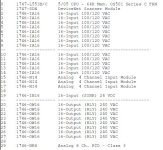Ken, could you please elaborate a little more on the 1788-EN2DN module.
We have six drive that are currently on the device net network, but we are thinking of replacing them with powerflex drives with a 22-comm-e modules.
I'm going to take a wild guess and say these are 160 series drives? I'm only saying that because I've seen so much of that out there. In fact at my last job I just replaced several 160s with Powerflex 4. Used DSI communication instead of Ethernet but I probably should have used the latter (that 1769-SM2 module is not fun to set up).
Personally, I would check out the PowerFlex 525 series that just came out. Ethernet is built-in on-board. No extra modules to buy (unless you want dual ports). And they can be programmed with a USB cable.
Ken's idea is a good one, but there are some fatal flaws. First, if these are indeed 160 or older series drives, you're still running an obsolete part and new replacements will be hard to find if not very expensive. Second, you're still running Devicenet, which isn't as reliable or as flexible as Ethernet/IP. When it works, it works well, but when it goes down, troubleshooting is a massive pain in the rear. I've seen Devicenet networks go down just from slightly moving one connector, yet other times you can pull the thing right out of the socket and everyone else will work just fine, and plugging the cable back in brings the node right back up again.
Keeping your old drives and network might save some time and money now, but later on you'll have to spend that money anyway plus the extra time to re-write your program. The way I see it, you have a choice between just updating everything now and biting the bullet budget-wise, or wait until some time in the near future when a drive goes down, you can't find any replacements, and you have to re-engineer the system in a rush. I prefer doing things once over doing them over (doesn't always happen that way, but it's what I prefer).






